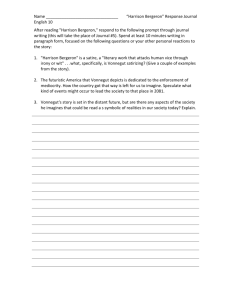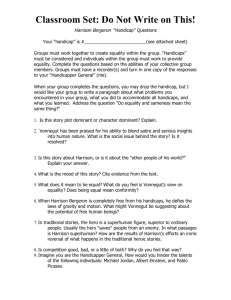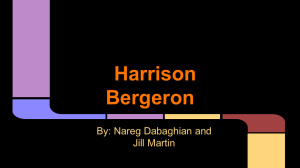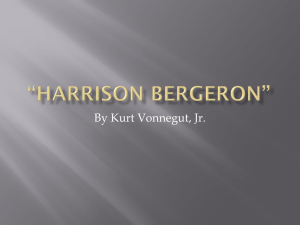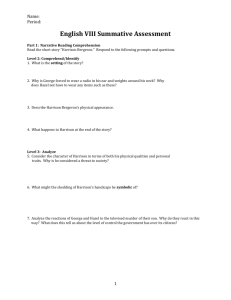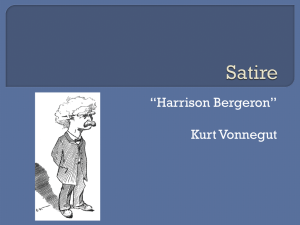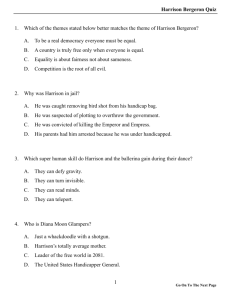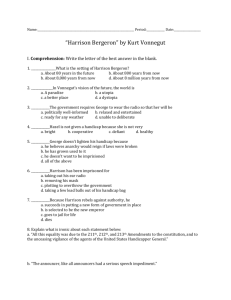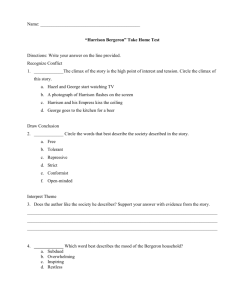Harrison Bergeron - Oakland High School
advertisement
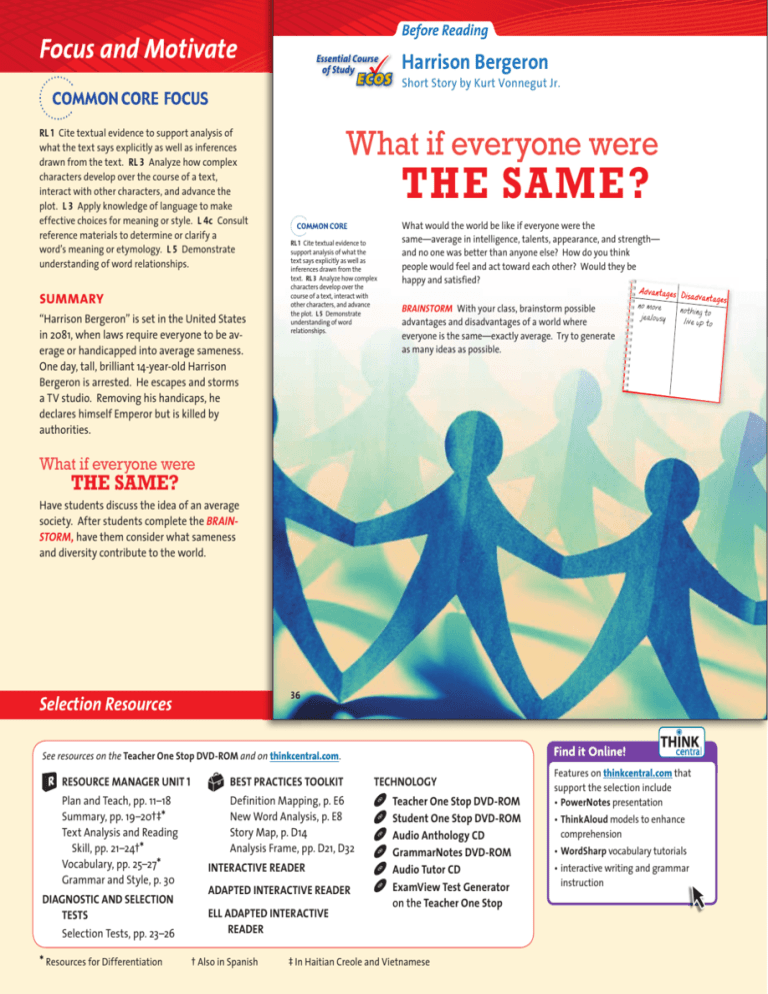
Before Reading Focus and Motivate Essential Course of Study ecos RL 1 Cite textual evidence to support analysis of what the text says explicitly as well as inferences drawn from the text. RL 3 Analyze how complex characters develop over the course of a text, interact with other characters, and advance the plot. L 3 Apply knowledge of language to make effective choices for meaning or style. L 4c Consult reference materials to determine or clarify a word’s meaning or etymology. L 5 Demonstrate understanding of word relationships. summary “Harrison Bergeron” is set in the United States in 2081, when laws require everyone to be average or handicapped into average sameness. One day, tall, brilliant 14-year-old Harrison Bergeron is arrested. He escapes and storms a TV studio. Removing his handicaps, he declares himself Emperor but is killed by authorities. Harrison Bergeron Short Story by Kurt Vonnegut Jr. What if everyone were THE SAME ? RL 1 Cite textual evidence to support analysis of what the text says explicitly as well as inferences drawn from the text. RL 3 Analyze how complex characters develop over the course of a text, interact with other characters, and advance the plot. L 5 Demonstrate understanding of word relationships. What would the world be like if everyone were the same—average in intelligence, talents, appearance, and strength— and no one was better than anyone else? How do you think people would feel and act toward each other? Would they be happy and satisfied? BRAINSTORM With your class, brainstorm possible advantages and disadvantages of a world where everyone is the same—exactly average. Try to generate as many ideas as possible. Advantag es Disadvan tages no more nothing to jealousy live up to What if everyone were THE SAME? Have students discuss the idea of an average society. After students complete the BRAINSTORM, have them consider what sameness and diversity contribute to the world. 36 Selection Resources NA_L10PE-u01s1-brHar.indd 36 12/25/10 3:47:1 Find it Online! See resources on the Teacher One Stop DVD-ROM and on thinkcentral.com. RESOURCE MANAGER UNIT 1 BEST PRACTICES TOOLKIT Plan and Teach, pp. 11–18 Summary, pp. 19–20†‡* Text Analysis and Reading Skill, pp. 21–24†* Vocabulary, pp. 25–27* Grammar and Style, p. 30 Definition Mapping, p. E6 New Word Analysis, p. E8 Story Map, p. D14 Analysis Frame, pp. D21, D32 DIAGNOSTIC AND SELECTION TESTS Selection Tests, pp. 23–26 * Resources for Differentiation INTERACTIVE READER ADAPTED INTERACTIVE READER TECHNOLOGY Teacher One Stop DVD-ROM Student One Stop DVD-ROM Audio Anthology CD GrammarNotes DVD-ROM Audio Tutor CD ExamView Test Generator on the Teacher One Stop ELL ADAPTED INTERACTIVE READER † Also in Spanish ‡ In Haitian Creole and Vietnamese Features on thinkcentral.com that support the selection include • PowerNotes presentation • ThinkAloud models to enhance comprehension • WordSharp vocabulary tutorials • interactive writing and grammar instruction Meet the Author text analysis: plot and conflict The plot of a story is driven by a conflict, or struggle between opposing forces. In some stories, the conflict is between the main character and society. In “Harrison Bergeron,” for example, the title character struggles with U.S. society in the year 2081. As you read, notice ways in which Harrison and the government oppose each other. Follow events to see who prevails. reading skill: draw conclusions When you draw conclusions, you make judgments based on story details and your own prior knowledge. Use the following strategies to draw conclusions about the society depicted in “Harrison Bergeron”: • Note what results from the society’s practices and laws. • Apply your own knowledge to speculate about the motives of its officials. As you read “Harrison Bergeron,” use a chart like the one shown to make notes about the society. Also include your own thoughts or reactions about the information. Details About Society Constitutional amendments make everyone equal in every way. My Reactions It would be hard to enforce equality. vocabulary in context Vonnegut uses the following words in relating his futuristic tale. To see how many words you already know, substitute a different word or phrase for each boldfaced term. Write your answers in your Reader/Writer Notebook. 1. vigilance with the children crossing the street Kurt Vonnegut Jr. 1922–2007 Serious Humor Kurt Vonnegut Jr. was one of the most acclaimed satiric writers in America. After working briefly as a journalist, he began writing short stories in the late 1940s and continued writing stories, novels, dramas, and essays for more than 50 years. His fiction deals with sobering topics—war, brutality, and fear of technology. But Vonnegut writes with dark humor and elements of fantasy and even absurdity, which have given his writing lasting appeal. Voice of Experience During World War II, Vonnegut was held as a prisoner of war in Dresden, Germany. The city was leveled by a fierce firebombing, and the destruction and horror of that event became the focus of his most famous novel, Slaughterhouse Five. Vonnegut wrote in a preface to the novel that it was about “the inhumanity of many of man’s inventions to man.” Vonnegut’s early work was not well received by critics, but since the 1970s he has been regarded as a major American writer. What’s Your Handicap? If you have ever run a footrace or played golf, you might know the sports term handicap. It refers to a way to even up a game so that good, average, and poor players can compete as equals. In a footrace, for example, faster runners might handicap themselves by giving slower runners a head start. In “Harrison Bergeron,” people are given handicaps in daily life so that no one will be any stronger, smarter, or better looking than anyone else. 3. filled with consternation at the thought 4. cower in the corner 5. synchronize our watches 6. neutralizing the impact T E X T A N A LY S I S RL 3 Model the Skill: plot and conflict To model how to identify conflicts in a story, point out that a conflict can be either physical or psychological. It can be within a character, between characters, or between a character and an outside force. Ask what conflict might arise between a genius and a government that wants everyone to be average. Point out that the government might try to take away the genius’s special gifts or hurt the genius. GUIDED PRACTICE Have students identify conflicts in other stories. background to the story My Overall Conclusions 2. wince in pain after the injection Teach Author Online READING SKILL RL 1 Model the Skill: draw conclusions Have students read the text under Serious Humor and Voice of Experience. Then point out that Vonnegut experienced the war firsthand. Ask them to draw a conclusion as to why Vonnegut may have chosen to write a novel about World War II. GUIDED PRACTICE Have students read the text under What’s Your Handicap? Ask what they might conclude about a golfer with a huge handicap. Go to thinkcentral.com. tral.com.. KEYWORD: HML10-37 0-37 Complete the activities in your Reader/Writer Notebook. RESOURCE MANAGER—Copy Master Draw Conclusions p. 23 37 NA_L10PE-u01s1-brHar.indd 37 12/25/10 3:47:19 PM VOCABULARY SKILL vocabulary in context DIAGNOSE WORD KNOWLEDGE Have all students complete Vocabulary in Context. Check their words and phrases against the following: consternation (kJnQstEr-nAPshEn) n. confused amazement or fear cower (kouPEr) v. to crouch down in fear synchronize (sGngPkrE-nFzQ) v. to match the timing of neutralize (nLPtrE-lFzQ) v. to counteract or cancel the effect of vigilance (vGjPE-lEns) n. alert attention, watchfulness wince (wGns) v. to shrink or flinch involuntarily, especially in pain PRETEACH VOCABULARY Use the following copy master to help students use context clues to determine the meaning of each boldfaced word. 1. Read item 1 aloud, emphasizing vigilance. L4 2. Point out “so they seldom broke laws” and “the government was watching.” Elicit possible meanings for vigilance, such as “watchfulness” or “alertness.” 3. Repeat the procedure for items 2–6. RESOURCE MANAGER—Copy Master Vocabulary Study p. 25 harrison bergeron 37 Harrison Practice and Apply Bergeron read with a purpose Help students set a purpose for reading. Tell them to look for ways in which Harrison differs from his parents, especially his father, as they read the story. Kurt Vonnegut Jr. READING SKILL RL 1 a Model the Skill: draw conclusions Model for students how to draw conclusions. Have students reread lines 1–17 and identify details that describe society in 2081. Have them record the details in their Details About Society charts. Then ask students how they think this society might treat someone who was not average. Possible answer: Specific details include: Laws require conformity (lines 4–6, 14–15), and this is maintained even in private homes (lines 15–17). The government requires that intelligent people wear government transmitters, which limit their ability to think (lines 15–17). This society is repressive and intrusive. It took away the Bergerons’ young son (lines 9–10). 10 20 VOCABULARY L4 own the word vigilance: Tell students that vigilance is a noun and that the adjective form is vigilant. Then ask students to name times when they would be most vigilant. How might they show vigilance? Why is it necessary to be vigilant? Possible answers: in a crowd, away from home, when surrounded by strangers; watch people around them carefully, hold tight to their belongings; to prevent physical harm or theft. The year was 2081, and everybody was finally equal. They weren’t only equal before God and the law. They were equal every which way. Nobody was smarter than anybody else. Nobody was better looking than anybody else. Nobody was stronger or quicker than anybody else. All this equality was due to the 211th, 212th, and 213th Amendments to the Constitution, and to the unceasing vigilance of agents of the United States Handicapper General. Some things about living still weren’t quite right, though. April, for instance, still drove people crazy by not being springtime. And it was in that clammy month that the H-G men took George and Hazel Bergeron’s fourteen-year-old son, Harrison, away. It was tragic, all right, but George and Hazel couldn’t think about it very hard. Hazel had a perfectly average intelligence, which meant she couldn’t think about anything except in short bursts. And George, while his intelligence was way above normal, had a little mental handicap radio in his ear. He was required by law to wear it at all times. It was tuned to a government transmitter.1 Every twenty seconds or so, the transmitter would send out some sharp noise to keep people like George from taking unfair advantage of their brains. a George and Hazel were watching television. There were tears on Hazel’s cheeks, but she’d forgotten for the moment what they were about. On the television screen were ballerinas. A buzzer sounded in George’s head. His thoughts fled in panic, like bandits from a burglar alarm. “That was a real pretty dance, that dance they just did,” said Hazel. “Huh?” said George. “That dance—it was nice,” said Hazel. “Yup,” said George. He tried to think a little about the ballerinas. They weren’t really very good—no better than anybody else would have been, anyway. They were burdened with sashweights2 and bags of birdshot,3 and vigilance (vGjPE-lEns) n. alert attention, watchfulness 1 Targeted Passage a DRAW CONCLUSIONS Reread lines 1–17. Cite specific details that describe society in 2081. What is your opinion of the society so far? Examine the image of the television announcer and the picture behind him. What does this painting suggest about television? 1. transmitter: an electronic device for broadcasting radio signals. 2. sashweights: lead weights used in some kinds of windows to keep them from falling shut when raised. 3. birdshot: tiny lead pellets made to be loaded in shotgun shells. 38 unit 1: plot, setting, and mood Detail of TVTime-Announcer (2002), Charles Foster-Hall. Acrylic on canvas, 16” × 20”, 41cm x 51 cm. © Charles Foster-Hall. NA_L10PE-u01s1-Har.indd 38 12/25/10 3:46 differentiated instruction for english language learners for struggling readers Vocabulary Support Use Definition Mapping to teach these words: “amendments” (line 5), “intelligence” (line 12), “normal” (line 14), “mental” (line 14), “required” (line 14). In combination with the Audio Anthology CD, use one or more Targeted Passages (pp. 38, 41, 43, 44) to ensure that students focus on key story events, concepts, and skills. Targeted Passages are also good for English learners. BEST PRACTICES TOOLKIT—Transparency Definition Mapping p. E6 1 Targeted Passage [Lines 7–28] This passage introduces the conflict of the story and the main characters. • What happens to Harrison Bergeron, and how do his parents react? (lines 9–12) 38 unit 1 : plot, setting, and mood Reading Support This selection on thinkcentral.com includes embedded ThinkAloud models–students “thinking aloud” about the story to model the kinds of questions a good reader would ask about a selection. background Utopian Society This story describes an attempt to create a Utopian, or perfect, society in the United States by abolishing all kinds of competition. For centuries, writers have described perfect societies: Plato wrote about one in Republic. The word Utopian comes from Sir Thomas More’s book Utopia. George Orwell and Aldous Huxley both wrote famous satires on Utopian societies. This story is written in the same tradition. Analyze Visuals Possible answer: The announcer’s strained face and gritted teeth suggest tension, and the triangular cap makes him appear to be either a puppet or a dunce. The graphics beside him are dark, murky, and confused, suggesting that the content of the television show is the same. The blurred lines create a barrier between the viewer and the announcer. About the Art Contemporary artist Charles Foster-Hall was born in the United Kingdom, where he studied art, science, and engineering. He went on to Paris to study art, and he now lives in New York. He painted TVTime-Announcer in 2002. It is from a series of paintings called TVTime. A_L10PE-u01s1-Har.indd 39 • What makes George and Hazel equal? (lines 4–6) • Why does George have to try “to think a little about the ballerinas”? What do you think will happen to him as he is thinking? (lines 13–17) 12/25/10 3:46:48 PM for advanced learners/pre–ap Make Judgments Begin a class discussion by asking students to think about how much control a government should have in the lives of its citizens. What controls are appropriate? When does the role of government go too far? Encourage students to use specific examples when expressing their opinions. revisit the big question What if everyone were THE SAME? Discuss Based on lines 14–28, What does the government do to people who are above average in some way? Possible answer: It handicaps them. George is considered to have aboveaverage intelligence and is forced to wear a mental handicap radio (line 14). The ballerinas are “burdened with sashweights and bags of birdshot” (line 28) so that they are average. harrison bergeron 39 30 READING SKILL b draw conclusions RL 1 Possible answer: The society allows the government to disrupt people’s thoughts by blasting them with noise (line 32). It does not allow people, like ballerinas, to be any better than anybody else. It makes them wear “sashweights and bags of birdshot” (line 28). 40 T E X T A N A LY S I S c plot and conflict RL 3 Possible answer: George thinks about his “abnormal son who was now in jail” (lines 51–52). Since above-average looks and abilities are considered abnormal and illegal by this government, Harrison was probably above average in some respects. Perhaps he was more attractive, more intelligent, or more talented than average. 50 60 tiered discussion prompts Direct students to lines 58–69. Use these prompts to help students think about George’s plight: Analyze What is ironic about Hazel’s statement to George about not caring whether he is equal to her for a while? Possible answer: Because Hazel is average, she cannot really ponder the meaning of that statement. She is not the one suffering like George is. Evaluate Do you think that George’s situation is better or worse than Hazel’s? Students’ responses should reflect whether it is better to have never known something or to have known and lost it. VOCABULARY L4 own the word wince: Tell students that the word wince refers to facial or body movements, such as grimacing or shuddering. Ask students to list situations that might cause them to wince as George did. Possible answers: hearing bad news, having a cavity filled their faces were masked, so that no one, seeing a free and graceful gesture or a pretty face, would feel like something the cat drug in. George was toying with the vague notion that maybe dancers shouldn’t be handicapped. But he didn’t get very far with it before another noise in his ear radio scattered his thoughts. George winced. So did two out of the eight ballerinas. Hazel saw him wince. Having no mental handicap herself, she had to ask George what the latest sound had been. “Sounded like somebody hitting a milk bottle with a ball peen hammer,”4 said George. “I’d think it would be real interesting, hearing all the different sounds,” said Hazel, a little envious. “All the things they think up.” “Um,” said George. b “Only, if I was Handicapper General, you know what I would do?” said Hazel. Hazel, as a matter of fact, bore a strong resemblance to the Handicapper General, a woman named Diana Moon Glampers. “If I was Diana Moon Glampers,” said Hazel, “I’d have chimes on Sunday—just chimes. Kind of in honor of religion.” “I could think, if it was just chimes,” said George. “Well—maybe make ’em real loud,” said Hazel. “I think I’d make a good Handicapper General.” “Good as anybody else,” said George. “Who knows better’n I do what normal is?” said Hazel. “Right,” said George. He began to think glimmeringly about his abnormal son who was now in jail, about Harrison, but a twenty-one-gun salute in his head stopped that. c “Boy!” said Hazel, “that was a doozy, wasn’t it?” It was such a doozy that George was white and trembling, and tears stood on the rims of his red eyes. Two of the eight ballerinas had collapsed to the studio floor and were holding their temples. “All of a sudden you look so tired,” said Hazel. “Why don’t you stretch out on the sofa, so’s you can rest your handicap bag on the pillows, honeybunch.” She was referring to the forty-seven pounds of birdshot in a canvas bag, which was padlocked around George’s neck. “Go on and rest the bag for a little while,” she said. “I don’t care if you’re not equal to me for a while.” George weighed the bag with his hands. “I don’t mind it,” he said. “I don’t notice it any more. It’s just a part of me.” “You been so tired lately—kind of wore out,” said Hazel. “If there was just some way we could make a little hole in the bottom of the bag, and just take out a few of them lead balls. Just a few.” “Two years in prison and two thousand dollars fine for every ball I took out,” said George. “I don’t call that a bargain.” unit 1 : plot, setting, and mood b DRAW CONCLUSIONS How does the society affect the thoughts and reactions of the people? How does it influence their job performance? c PLOT AND CONFLICT George’s thoughts reveal more about the conflict between Harrison and the society. On the basis of what you’ve read so far, what behavior do you think might be viewed as abnormal and illegal? 4. ball peen hammer: a hammer with a head having one flat side and one rounded side. 40 unit 1: plot, setting, and mood NA_L10PE-u01s1-Har.indd 40 12/25/10 3:46: differentiated instruction for struggling readers for advanced learners/pre–ap Develop Reading Fluency Model for students an effective way to read the conversation between George and Hazel in lines 41–54. You might ask for a volunteer to read the dialog of one character while you read the other. Point out that the two characters often use nonstandard English when they talk. Then have pairs of students practice reading the dialogue aloud together. Evaluate Explain to students that this story is a satire and is designed to arouse mocking laughter. Point out that Hazel is described as someone with average intelligence. Ask students to find statements that Hazel makes and explain how the author mocks what is “average” through these statements. Ask students to consider what point the author is trying to make about the society depicted. RESOURCE MANAGER—Copy Masters 40 wince (wGns) v. to shrink or flinch involuntarily, especially in pain Reading Fluency p. 31 “If you could just take a few out when you came home from work,” said Hazel. “I mean—you don’t compete with anybody around here. You just set around.” “If I tried to get away with it,” said George, “then other people’d get away with it—and pretty soon we’d be right back to the dark ages again, with everybody competing against everybody else. You wouldn’t like that, would you?” “I’d hate it,” said Hazel. “There you are,” said George. “The minute people start cheating on laws, what do you think happens to society?” 80 If Hazel hadn’t been able to come up with an answer to this question, George couldn’t have supplied one. A siren was going off in his head. “Reckon it’d fall all apart,” said Hazel. “What would?” said George blankly. “Society,” said Hazel uncertainly. “Wasn’t that what you just said?” “Who knows?” said George. d The television program was suddenly interrupted for a news bulletin. It wasn’t clear at first as to what the bulletin was about, since the announcer, like all announcers, had a serious speech impediment.5 For about half a minute, and in a state of high excitement, the announcer tried to say, “Ladies and 90 gentlemen—” He finally gave up, handed the bulletin to a ballerina to read. “That’s all right—” Hazel said of the announcer, “he tried. That’s the big thing. He tried to do the best he could with what God gave him. He should get a nice raise for trying so hard.” “Ladies and gentlemen—” said the ballerina, reading the bulletin. She must have been extraordinarily beautiful, because the mask she wore was hideous. And it was easy to see that she was the strongest and most graceful of all the dancers, for her handicap bags were as big as those worn by two-hundredpound men. 100 And she had to apologize at once for her voice, which was a very unfair voice for a woman to use. Her voice was a warm, luminous, timeless melody. “Excuse me—” she said, and she began again, making her voice absolutely uncompetitive. “Harrison Bergeron, age fourteen,” she said in a grackle6 squawk, “has just escaped from jail, where he was held on suspicion of plotting to overthrow the government. He is a genius and an athlete, is under-handicapped, and should be regarded as extremely dangerous.” e A police photograph of Harrison Bergeron was flashed on the screen— upside down, then sideways, upside down again, then right side up. The 70 READING SKILL d DRAW CONCLUSIONS Reread lines 68–85. What do you think of George’s reasons for not lightening his handicap bag? L5 Language Coach 2 Targeted Passage PLOT AND CONFLICT Here the rising action begins. What more do you learn about the conflict between Harrison and the society? NA_L10PE-u01s1-Har.indd 41 • How can you tell that she is the strongest and most graceful dancer? (lines 97–99) Possible answer: George’s reasons seem rational in some ways. He does not want to go to prison and be fined (lines 68–69). He also seems to be concerned about how the actions of lightening his bag might affect others (lines 73–75). But his reasons also show that he has resigned himself to the government’s ways. He feels that the laws hold society together and make it pleasant for everyone (lines 73–79). T E X T A N A LY S I S e Model the Skill: plot and conflict Model how to identify and understand the plot’s conflict. • Break the question into two separate parts. Have students first focus on Harrison and what they know about him. harrison bergeron This passage shows the relationship between natural attributes and handicaps, and it also shows how someone who is compliant behaves. RL 1 RL 3 e 5. speech impediment (Gm-pDdPE-mEnt): a physical defect that prevents a person from speaking normally. 2 Targeted Passage [Lines 95–103] draw conclusions Antonyms Reread lines 95–96. An antonym is a word that means the opposite of another word. Which word in this sentence is an antonym for beautiful? 6. grackle: a blackbird with a harsh, unpleasant call. for struggling readers d 41 12/25/10 3:46:55 PM for english language learners Language Coach L5 Antonyms Answer: hideous; Have students reread lines 97–103. Ask students to name antonyms, or opposites, for the following words: “easy,” “strongest,” and “graceful” (line 97); “unfair” (line 100); and “warm” (line 101). • Then ask what the government says and does with its news bulletin. Possible answer: Harrison “was held on suspicion of plotting to overthrow the government”; he is a genius, an athlete, and “under-handicapped” (line 106). The society treats him like a dangerous criminal. They interrupt television shows, flash his picture, and warn the population about him. Extend the Discussion Is Harrison’s relationship to the government similar to his parents’ relationship to the government? • Why does she apologize for her voice? (lines 100–104) harrison bergeron 41 Analyze Visuals Possible answer: The figures are white, almost featureless blobs, who stare with blank eyes at what is before them. Their passivity and lack of color reflect George’s and Hazel’s resigned acceptance of their lives as well as their sameness. About the Art This painting, like the one on page 39, is also from Charles Foster-Hall’s series TVTime. revisit the big question What if everyone were THE SAME? TVTime 2 (2002), Charles Foster-Hall. Acrylic on canvas, 16˝ × 28˝, 41 cm x 72 cm. © Charles Foster-Hall. Discuss In lines 111–125, how does Harrison remain above average, even with handicaps? What is ironic about how Harrison looks as compared to the other handicapped people? Possible answer: He “had outgrown hindrances faster than the H-G men could think them up” (lines 113–114). He challenges the government to keep thinking up ways to make him average. Harrison looks above average in his handicaps. He looks like a “walking junkyard” (line 120). 110 120 T E X T A N A LY S I S f plot and conflict RL 3 Possible answer: He has been handicapped because he is so above average. For example, he is seven feet tall (line 111) and good-looking (line 122). IF STUDENTS NEED HELP . . . Have students work together to complete a Two-Column Chart. Label column 1 “Harrison’s Handicaps,” and label column 2 “Designed to make average . . . .” 130 42 picture showed the full length of Harrison against a background calibrated in feet and inches. He was exactly seven feet tall. The rest of Harrison’s appearance was Halloween and hardware. Nobody had ever born heavier handicaps. He had outgrown hindrances faster than the H-G men could think them up. Instead of a little ear radio for a mental handicap, he wore a tremendous pair of earphones, and spectacles with thick wavy lenses. The spectacles were intended to make him not only half blind, but to give him whanging headaches besides. Scrap metal was hung all over him. Ordinarily, there was a certain symmetry, a military neatness to the handicaps issued to strong people, but Harrison looked like a walking junkyard. In the race of life, Harrison carried three hundred pounds. And to offset his good looks, the H-G men required that he wear at all times a red rubber ball for a nose, keep his eyebrows shaved off, and cover his even white teeth with black caps at snaggle-tooth random. f “If you see this boy,” said the ballerina, “do not—I repeat, do not—try to reason with him.” There was the shriek of a door being torn from its hinges. Screams and barking cries of consternation came from the television set. The photograph of Harrison Bergeron on the screen jumped again and again, as though dancing to the tune of an earthquake. How would you describe the figures watching television? How well do they represent George and Hazel? f PLOT AND CONFLICT Why has Harrison been so handicapped by the government? consternation (kJnQstEr-nAPshEn) n. confused amazement or fear unit 1: plot, setting, and mood NA_L10PE-u01s1-Har.indd 42 BEST PRACTICES TOOLKIT—Transparency 12/25/10 3:46: differentiated instruction Two-Column Chart p. A25 VOCABULARY L4 own the word consternation: Have students make a list of situations that might lead to feelings of consternation. 42 unit 1 : plot, setting, and mood for english language learners for advanced learners/pre–ap Language: Compound Nouns Explain that a compound word is two or more words that are put together to form one. Point out the compound noun “background” (line 110). Have students try to figure out its meaning in context and by defining back and ground. Ask pairs to find other compound nouns in the text and try to define them in the same way (“earphones” [line 115]; “headaches” [line 117]; “junkyard” [line 120]; “earthquake” [line 130]). Analyze Humor Have pairs analyze Vonnegut’s style to determine how he injects humor into this story. For example, point out to students that he uses alliteration (“Halloween”, “hardware”, “heavier handicaps”—lines 112–113) when describing Harrison. Ask pairs to find examples of hyperbole, imagery, irony, and other literary devices from the story. Have pairs share their examples with the class and explain what the humor adds to the story. 140 150 160 170 George Bergeron correctly identified the earthquake, and well he might g GRAMMAR AND STYLE have—for many was the time his own home had danced to the same crashing Reread line 138. Notice tune. “My God—” said George, “that must be Harrison!” how Vonnegut uses the precise adjectives The realization was blasted from his mind instantly by the sound of an clanking, clownish, and automobile collision in his head. huge to create a vivid When George could open his eyes again, the photograph of Harrison was image of Harrison’s gone. A living, breathing Harrison filled the screen. appearance. Clanking, clownish, and huge, Harrison stood in the center of the studio. g The knob of the uprooted studio door was still in his hand. Ballerinas, cower (kouPEr) v. to crouch technicians, musicians, and announcers cowered on their knees before him, down in fear expecting to die. “I am the Emperor!” cried Harrison. “Do you hear? I am the Emperor! Everybody must do what I say at once!” He stamped his foot and the studio shook. “Even as I stand here—” he bellowed, “crippled, hobbled, sickened—I am a greater ruler than any man who ever lived! Now watch me become what I can become!” Harrison tore the straps of his handicap harness like wet tissue paper, tore straps guaranteed to support five thousand pounds. Harrison’s scrap-iron handicaps crashed to the floor. Harrison thrust his thumbs under the bar of the padlock that secured his head harness. The bar snapped like celery. Harrison smashed his headphones and spectacles against the wall. He flung away his rubber-ball nose, revealed a man that would have awed Thor, the god of thunder. “I shall now select my Empress!” he said, looking down on the cowering people. “Let the first woman who dares rise to her feet claim her mate and her h PLOT AND CONFLICT throne!” h Reread lines 142–158. A moment passed, and then a ballerina arose, swaying like a willow. Notice how Harrison views Harrison plucked the mental handicap from her ear, snapped off her himself in relation to other physical handicaps with marvelous delicacy. Last of all, he removed her mask. people. How do his views She was blindingly beautiful. put him in conflict with the government? “Now—” said Harrison, taking her hand, “shall we show the people the meaning of the word dance? Music!” he commanded. The musicians scrambled back into their chairs, and Harrison stripped them of their handicaps, too. “Play your best,” he told them, “and I’ll make you 3 Targeted Passage barons and dukes and earls.” The music began. It was normal at first—cheap, silly, false. But Harrison snatched two musicians from their chairs, waved them like batons as he sang the music as he wanted it played. He slammed them back into their chairs. The music began again and was much improved. harrison bergeron NA_L10PE-u01s1-Har.indd 43 for struggling readers 3 Targeted Passage [Lines 159–171] This passage explains why Harrison is such a threat to a government that insists everyone be equal in every way. • What does Harrison do to the ballerina and the musicians? (lines 160–166) • Why would the government disapprove of Harrison’s actions? (line 166) • Do you think his actions are fair to the ballerina and the musicians? (lines 162, 166–171) 43 12/25/10 3:46:58 PM g grammar and style L3 Identify Precise Adjectives Point out that the author uses precise adjectives that appeal to many senses, including sight and sound. Precise adjectives create images in readers’ minds. Have students identify other precise adjectives in the story. Possible answers: “white and trembling” (line 55) appeal to sight; “warm” (line 101), “barking” (line 128), and “crashing” (line 132) appeal to sound; “wet” (line 148) and “rubber-ball” (line 154) appeal to touch T E X T A N A LY S I S h plot and conflict RL 3 Possible answer: Harrison declares himself Emperor (line 142), and says he is a “greater ruler than any man who ever lived”(line 146), directly challenging the government’s authority. He also removes all his handicaps (lines 148–155), which is against the law. tiered discussion prompts Refer to lines 159–171, and use these prompts to help students understand the enormity of Harrison’s “crimes”: Analyze How are Harrison’s actions an attempt to overthrow the government? Possible answer: He not only breaks the laws but he tries to get others to do the same. Synthesize Considering how the government punishes people for removing lead balls from their handicaps, how will Harrison most likely be punished? Possible answer: He would probably be locked up forever. for english language learners Comprehension: Transitions Point out these transition words that are used to create comparisons: “like bandits” (line 21); “‘I am a greater ruler than’” (lines 145–146); “waved them like batons” (line 169); “as though synchronizing” (line 173); “leaped like deer” (line 181). Have pairs work together to write one sentence about the story that uses each of these transition words. VOCABULARY L4 own the word cower: Have students create a semantic map for the word cower. Write the word in a center circle, and add the definition given. Draw spider legs from the center circle, and have students add synonyms to complete the map. Possible answers: cringe, recoil, flinch, shrink harrison bergeron 43 READING SKILL RL 1 i draw conclusions Possible answer: Use of such playful verbs as “reeled, whirled, swiveled, flounced” (line 180), the comparison “They leaped like deer on the moon” (line 181), and the emphasis on kissing and love indicate that the narrator views it as joyful and exciting. 180 T E X T A N A LY S I S j plot and conflict RL 3 190 Possible answer: when the Handicapper General shoots and kills Harrison READING SKILL RL 1 k draw conclusions Possible answer: George was shaken by a handicap signal (lines 197–198) and cannot remember what happened to his son. Hazel’s mind is mixed up (line 203) and she forgets sad things (line 205). 200 VOCABULARY L4 own the word • synchronize: Have students complete this sentence: The coach said that the two divers were perfectly synchronized because. . . . Possible answer: they entered the water at exactly the same time. • neutralize: Remind students that when a person’s power is neutralized, his or her powers have been rendered ineffective. Have students refer to line 186 in which gravity was neutralized. 210 Harrison and his Empress merely listened to the music for a while—listened gravely, as though synchronizing their heartbeats with it. synchronize (sGngPkrE-nFzQ) v. to They shifted their weights to their toes. match the timing of Harrison placed his big hands on the girl’s tiny waist, letting her sense the weightlessness that would soon be hers. And then, in an explosion of joy and grace, into the air they sprang! Not only were the laws of the land abandoned, but the law of gravity and the laws of motion as well. They reeled, whirled, swiveled, flounced, capered, gamboled, and spun. They leaped like deer on the moon. The studio ceiling was thirty feet high, but each leap brought the dancers nearer to it. It became their obvious intention to kiss the ceiling. neutralize (nLPtrE-lFzQ) v. They kissed it. to counteract or cancel And then, neutralizing gravity with love and pure will, they remained the effect of suspended in air inches below the ceiling, and they kissed each other for a long, long time. i i DRAW CONCLUSIONS Reread lines 177–188. It was then that Diana Moon Glampers, the Handicapper General, came What words and phrases into the studio with a double-barreled ten-gauge shotgun. She fired twice, and indicate how the narrator the Emperor and the Empress were dead before they hit the floor. views this breaking of Diana Moon Glampers loaded the gun again. She aimed it at the musicians the laws? and told them they had ten seconds to get their handicaps back on. j PLOT AND CONFLICT It was then that the Bergerons’ television tube burned out. j How is the conflict Hazel turned to comment about the blackout to George. But George had resolved? gone out into the kitchen for a can of beer. George came back in with the beer, paused while a handicap signal shook 4 Targeted Passage him up. And then he sat down again. “You been crying?” he said to Hazel. “Yup,” she said. “What about?” he said. “I forget,” she said. “Something real sad on television.” “What was it?” he said. “It’s all kind of mixed up in my mind,” said Hazel. “Forget sad things,” said George. “I always do,” said Hazel. “That’s my girl,” said George. He winced. There was the sound of a riveting gun7 in his head. k DRAW CONCLUSIONS “Gee—I could tell that one was a doozy,” said Hazel. Why do George and Hazel “You can say that again,” said George. react this way to their “Gee—” said Hazel, “I could tell that one was a doozy.” k son’s death? 7. riveting (rGvPG-tGng) gun: a power tool used to hammer bolts (called rivets) that are used in construction work and manufacturing to fasten metal beams or plates together. 44 unit 1: plot, setting, and mood NA_L10PE-u01s1-Har.indd 44 12/25/10 3:46: differentiated instruction for struggling readers selection wrap–up READ WITH A PURPOSE Now that students have finished reading the selection, have them compare and contrast Harrison with his parents, especially his father. What choices does Harrison make that his father would not or could not make? Possible answer: Harrison is willing to remove his handicaps; his father is not. 4 Targeted Passage [Lines 189–207] This passage contains the climax and resolution of the story. • What does Diana Moon Glampers do? (lines 189–191) • How does George react to the events? Why does he hear the sound of “a riveting gun in his head” (lines 206–207)? • What questions does he ask Hazel? (lines 198–202) 44 unit 1 : plot, setting, and mood for english language learners Vocabulary: Idioms Use New Word Analysis to teach these story idioms: drove people crazy (line 8), “upset people”; get away with (line 73), “do something bad and not get caught”; mixed up (line 203), “confused”; doozy (lines 208, 210), “something special”; You can say that again (line 209), “I agree with you completely.” BEST PRACTICES TOOLKIT—Transparency New Word Analysis p. E8 After Reading Practice and Apply Comprehension 1. Recall Why does the government handicap George but not Hazel? 2. Recall Why is the government looking for Harrison? 3. Recall What does the Handicapper General do to Harrison? 4. Clarify Why don’t Harrison’s parents respond with more feeling to what they have seen? RL 1 Cite textual evidence to support analysis of what the text says explicitly as well as inferences drawn from the text. RL 3 Analyze how complex characters develop over the course of a text, interact with other characters, and advance the plot. For preliminary support of post-reading questions, use these copy masters: RESOURCE MANAGER—Copy Masters Reading Check p. 28 Analyze Plot and Conflict p. 21 Question Support p. 29 Text Analysis Additional selection questions are provided for teachers on page 15. 5. Analyze Plot and Conflict Summarize the main conflict in “Harrison Bergeron.” How is this conflict resolved? How does the resolution help to make the story successful? answers Comprehension 6. Recognize Climax Recall that the climax, or turning point, is the high point of interest and tension in a story. What is the climax of this story? 1. Hazel already has average intelligence. 7. Draw Conclusions Look back at the chart you created as you read. What overall conclusions can you draw about the society depicted in the story? Consider how people must function and what has become “normal.” 2. He escaped from jail, where he was held on suspicion of plotting to overthrow the government. 8. Interpret Theme What is Vonnegut saying about improving society by makaing everyone average? Support your opinion with evidence from the story. 3. She shoots and kills him. 9. Evaluate Would society have been better off with Harrison in charge? Using a chart like this one, predict the effects of Harrison’s becoming emperor. 4. Hazel’s lack of intelligence and George’s handicap keep them from remembering or focusing on it. Harrison becomes emperor. Text Analysis 10. Synthesize Think about the criticisms of society made in “Harrison Bergeron.” What aspects of today’s society seem open to Vonnegut’s criticisms? Text Criticism 11. Critical Interpretation One critic has argued that Vonnegut portrays television as “a kind of desensitizing, numbing, and clearly thought-stifling, rather than thought-provoking, medium” that is partly responsible for the state of society. Do you agree or disagree? Support your opinion. What if everyone were THE SAME? Would you be happier if no one were better (or worse) than anyone else? harrison bergeron NA_L10PE-u01s1-arHar.indd 45 10. rewarding effort rather than results; everybody having equal play time on sports teams regardless of whether they are good or not Text Criticism Possible answers: 11. Agree: The television shows mediocre or poor performances; it is a tool of the government. Disagree: The television is the least of people’s problems. The Constitutional Amendments and the vigilant agents are the real cause of the society depicted. RL 1, RL 3 Possible answers: 5. common core focus Analyze Plot and Conflict Harrison Bergeron is in conflict with the government. He is an extraordinary person, and the government demands that he be equal to everybody else. He insists on being who he is and is killed by the government. The story’s dramatic resolution warns readers what could happen in a society if freedom and diversity are not valued. 6. The climax is the scene in which Harrison and the ballerina are suspended in mid-air and are then shot and killed for their actions (lines 180–191). 45 12/25/10 5:17:45 PM What if everyone were THE SAME? Students might consider the positive and negative effects a lack of diversity would have on individuals and society as a whole. Students might also think about whether being equal means being the same. 7. common core focus Draw Conclusions The society limits any potential for greatness. It is repressive, discriminatory, and dangerous (lines 1–6; 11–17; 55–62; 95–103; 112–117; 180–191). 8. Vonnegut is saying that making everyone average is no improvement; artists are compromised (lines 26–30, 100–101, 168); the handicaps harm people (lines 55–57); and humans are not allowed to reach their full potential (lines 145–147). 9. Yes. Harrison would remove peoples’ handicaps and allow diversity to flourish. harrison bergeron 45 Vocabulary in Context word list vocabulary practice consternation Write the letter of the word that is most different in meaning from the others. cower answers Vocabulary in Context 1. (a) vigilance, (b) attention, (c) alertness, (d) laziness 2. (a) grin, (b) flinch, (c) wince, (d) shrink vocabulary practice 1. d 4. a 2. a 5. d 3. b 6. b 3. (a) joy, (b) consternation, (c) happiness, (d) elation 4. (a) tower, (b) crouch, (c) cower, (d) cringe synchronize vigilance wince 5. (a) time, (b) synchronize, (c) set, (d) separate 6. (a) neutralize, (b) worsen, (c) lessen, (d) decrease RESOURCE MANAGER—Copy Master academic vocabulary in speaking Vocabulary Practice p. 26 • affect academic vocabulary in speaking Students should identify and discuss the social tendencies Vonnegut is warning against, for example, the desire for everyone to be equal, competing on a “level” playing field. Vonnegut seems to be recommending that people be wary of repressive governments that may try to limit potential for greatness. vocabulary strategy: the greek root syn neutralize • communicate • establish • identify Identify the social tendencies Vonnegut is warning against in “Harrison Bergeron.” Analyze the flaws of the society he depicts and discuss with a partner what Vonnegut seems to be recommending. Use at least one Academic Vocabulary word in your discussion. vocabulary strategy: the greek root syn The vocabulary word synchronize contains the Greek word root syn, which means “together” or “similar.” This root is found in a number of English words. To understand the meaning of words with syn, use context clues as well as your knowledge of the root. synthesize L 4c • Encourage students to begin by reading all the sentences and completing those that they can. For example, they will probably be familiar with synonym and synchronizing. Then have them look up any remaining definitions. L 4c Consult reference materials to determine or clarify a word’s meaning or etymology. syndrome syn synonym synchronize syndicate PRACTICE Write the word from the word web that best completes each sentence. Use context clues to help you or, if necessary, consult a dictionary or glossary. • Discuss other forms of the words. When syndicate is used as a verb, for instance, it might have various endings. A synthesizer is a musical instrument. 1. A _ is a group of symptoms that together indicate a disease. 2. A _ is a word that has the same or a similar meaning to another word. Possible answers: 1. syndrome 2. synonym 3. syndicate • definite 46 3. A _ is a company that is made up of different parts, such as a newspaper, a magazine, and a TV network. Interactive Vocabulary 4. Swimmers often _ their movements in an underwater ballet. Go to thinkcentral.com. 5. To _ something is to combine separate elements to form a whole. KEYWORD: HML10-46 unit 1: plot, setting, and mood 4. synchronize 5. synthesize RESOURCE MANAGER—Copy Master Vocabulary Strategy p. 27 Interactive Vocabulary Keywords direct students to a WordSharp tutorial on thinkcentral.com or to other types of vocabulary practice and review. 46 unit 1 : plot, setting, and mood NA_L10PE-u01s1-arHar.indd 46 12/25/10 5:17:46 differentiated instruction for english language learners for advanced learners/pre–ap Vocabulary: Cognates Ask students if any words in the word web have similar word parts and meanings in their languages. Encourage them to identify other words in their languages that begin with or contain syn-. The Greek Word Root syn Have students use the dictionary to find three additional words that begin with syn-. Have them write sentences for each word. The sentences should provide context clues to the words’ meanings. Language grammar and style: Use Precise Language Review the Grammar and Style note on page 43. Vonnegut creates effective images, such as the image of Harrison in the TV studio, by using precise adjectives. When describing people, places, and events in your own writing, choose adjectives that allow readers to easily visualize them. Avoid using such adjectives as good and nice, which are too general to give readers a true sense of what is described. Language L 3 Apply knowledge of language to make effective choices for meaning or style. • Discuss why the revisions improve the draft. For example, gigantic is more accurate and descriptive than big. (To learn more about using language effectively, see Writing Handbook, page R29.) Here are two examples of Vonnegut’s use of precise adjectives: She must have been extraordinarily beautiful, because the mask she wore was hideous. (lines 95–96) • Write these sentences on the board and ask students to replace the adjectives with ones that are more precise: Her voice was a warm, luminous, timeless melody. (line 101) Notice how the revisions in blue make this first draft more descriptive. Revise your own writing by using more precise adjectives. student model difficult L3 grammar and style The noises that George heard were loud. thunderous and painful Harrison wore gigantic big handicaps. smarter, stronger, and more attractive Harrison Bergeron has a big problem. He’s better than everyone else, and the One ballerina had a soothing nice voice. illegal government says that’s bad. RESOURCE MANAGER—Copy Master Use Precise Language p. 30 reading-writing connection YOUR reading-writing connection Increase your understanding of “Harrison Bergeron” by responding to this prompt. Then use the revising tip to improve your writing. • Encourage students to complete a story map, which will help them focus on the plot and conflict. Discuss what parts they will leave out so as not to give away the ending. TURN writing prompt revising tip Short Constructed Response: Description Review your response. How have you used precise adjectives to describe the people, places, and events in the film? Imagine that a film version of “Harrison Bergeron” is being released and you have been assigned to write a blurb, or brief description, for a local newspaper. In one or two paragraphs, describe the plot and conflict in a way that makes people want to see the movie. BEST PRACTICES TOOLKIT—Transparencies Story Map p. D14 Analysis Frame: Theme pp. D21, D32 Interactive Revision Go to thinkcentral.com. KEYWORD: HML10-47 Writing Online Theoffollowing tools are available online at All the interactive tools and features on thinkcentral.com and on WriteSmart WriteSmart are also available online CD-ROM: Graphic—in Organizers • Interactive thinkcentral.com the Writing Center. at • Interactive Student Models • Interactive Revision Lessons For additional grammar instruction, see GrammarNotes on thinkcentral.com. harrison bergeron NA_L10PE-u01s1-arHar.indd 47 for struggling writers • Explain that a newspaper blurb must name the film and tell something about it. Discuss different details to include. • Help students write a sentence that identifies the film and tells something about it. • Help them write a sentence that states the main conflict. • Discuss which parts of the story would be most likely to interest viewers. 47 12/25/10 5:17:47 PM Suggest that students use the first paragraph to name the film, its setting, main characters, and conflict. The second paragraph could describe one or more plot details. Assess and Reteach Assess DIAGNOSTIC AND SELECTION TESTS Selection Test A pp. 23–24 Selection Test B/C pp. 25–26 Interactive Selection Test on thinkcentral.com Reteach Level Up Online Tutorials on thinkcentral.com Reteaching Worksheets on thinkcentral.com Literature Lessons 5, 6, Reading Lesson 9, Vocabulary Lesson 6 harrison bergeron 47
